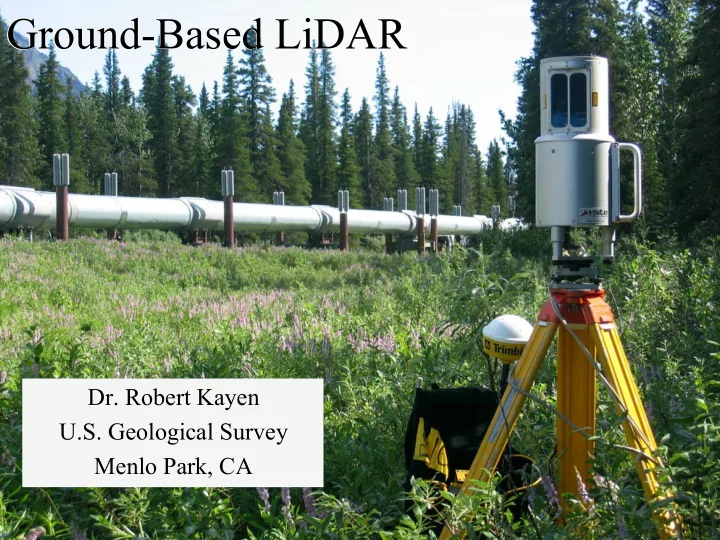

Ground-Based LiDAR Ground-Based LiDAR Dr. Robert Kayen Dr. Robert Kayen U.S. Geological Survey U.S. Geological Survey Menlo Park, CA Menlo Park, CA
The Reconnaissance Problem: The Reconnaissance Problem: We want to collect and archive highly We want to collect and archive highly detailed, accurate spatial measurements detailed, accurate spatial measurements of damaged ground and structures, and of damaged ground and structures, and do this rapidly, with limited budget? do this rapidly, with limited budget? Solution: Tripod-mounted LiDAR Solution: Tripod-mounted LiDAR
Ground-Based LiDAR Ground-Based LiDAR � LiDAR (Light Detection And Ranging) � LiDAR (Light Detection And Ranging) Distance = (Speed of Light x Time of Flight) / 2 QuickTime™ and a TIFF (Uncompressed) decompressor are needed to see this picture. � Portable & light tripod-mounted systems � Portable & light tripod-mounted systems � Fixed or Rotating laser-line scanner systems � Fixed or Rotating laser-line scanner systems � Produces 3-D target positions at up to 500k � Produces 3-D target positions at up to 500k positions/minute positions/minute � Range: Up To 1 kilometer around Tripod � Range: Up To 1 kilometer around Tripod under optimal atmospheric conditions under optimal atmospheric conditions
LiDAR & GEER: Bringing damage LiDAR & GEER: Bringing damage ground and structural morphologies ground and structural morphologies back to the lab for analysis, and as a back to the lab for analysis, and as a permanent record of event effects. permanent record of event effects. � Rapid data collection of damaged terrain. � Rapid data collection of damaged terrain. � Ultra-high accuracy terrain models for deformation � Ultra-high accuracy terrain models for deformation calculations and change detection . calculations and change detection . � Archive-quality spatial models of damage. � Archive-quality spatial models of damage. � 3-D spatial visuals and fly-through videos for � 3-D spatial visuals and fly-through videos for engineering analysis and public outreach. engineering analysis and public outreach.
USGS-GD Unit: USGS-GD Unit: Riegl z210i Riegl z210i USGS-WRD Unit: USGS-WRD Unit: Optech ILRIS-3D Optech ILRIS-3D
LiDAR Systems at the USGS LiDAR Systems at the USGS OpTech ILRIS-3D Riegl z210i Narrow window General Purpose High-Res Mapper Mapper: • 300m+ Range • 700m+ Range • Max. X,Y,Z • Max. X,Y,Z Accuracy 0.3-0.4 Accuracy 0.9 cm cm • Targets: 5.6M in • Targets: 1.8M in 11 minutes 15 minutes • Scan window: 80 ° by 336 ° • Fixed window: 40 ° by 40 ° USGS-Geologic Division System USGS-Water Resources Division System
Denali Fault offset at Denali Fault offset at Trans Alaska Pipeline, 7/2004: Trans Alaska Pipeline, 7/2004: Single Riegl z210i Scan range 580m Single Riegl z210i Scan range 580m
LiDAR Systems at the USGS LiDAR Systems at the USGS OpTech ILRIS-3D Riegl z210i Narrow window General Purpose High-Res Mapper Mapper: • 300m+ Range • 700m Range • Max. X,Y,Z • Max. X,Y,Z Accuracy 0.3-0.4 Accuracy 0.9 cm cm • Target points: • Target Points: 5.6M in 11 minutes 1.8M in 15 minutes • Scan window: 80 ° by 336 ° • Fixed window: 40 ° by 40 ° USGS-GD System USGS-WRD System
Point Resolution Point Resolution Spacing : ~2mm Spacing : ~2mm Traditional post- near tripod near tripod slip survey marks with 9mm 3-D resolution with 9mm 3-D resolution Parkfield 10/4/04 Fissure Fissure ~30 cm
Sub-cm 3-D spatial deformation measurements of minor or significant damage at distances up to 700-1000m Minor Minor Fissures Fissures Parkfield 10/4/2004
LiDAR Data Processing LiDAR Data Processing OpTech ILRIS-3D Riegl z210i Multiple scans to Single or Multiple expand scan scans. window & eliminate Merge point cloud shadow zones. data with I-Site3D Merge point cloud Triangulated data, produce surface (TIN) for triangulated measurement and surface (TIN) with change detection PolyWorks. using I-Site3D USGS-WRD System USGS-GD System
10 m Example: single scan of 50- Example: single scan of 50- 60 cm Denali Fault scarp. 60 cm Denali Fault scarp. Merging scans to eliminate Merging scans to eliminate shadow zones shadow zones
Denali Fault: Merge of 2 scans to produce fewer shadow (no data) zones in surface model. High quality DGPS geo-referencing needed for merge.
Denali Fault: Merging of 8 scans to produce a largely Denali Fault: Merging of 8 scans to produce a largely shadow free surface model of rupture shadow free surface model of rupture
TIN surfaces ready for change detection analysis Collins & Sitar, 2003, AEG Ann. Mtg.
Summary Summary � GEER-EERI-USGS can utilize ground-based � GEER-EERI-USGS can utilize ground-based LiDAR to collect damage morphology data at LiDAR to collect damage morphology data at speeds, accuracies, and range that was previously speeds, accuracies, and range that was previously unimaginable in earthquake reconnaissance. unimaginable in earthquake reconnaissance. � These permanently archived terrain models will � These permanently archived terrain models will vastly improve controls on empirical deformation vastly improve controls on empirical deformation studies and allow researchers decades later to studies and allow researchers decades later to virtually-revisit damage sites. virtually-revisit damage sites.
Ground-Based LiDAR Ground-Based LiDAR Dr. Robert Kayen Dr. Robert Kayen U.S. Geological Survey U.S. Geological Survey Menlo Park, CA Menlo Park, CA
Recommend
More recommend